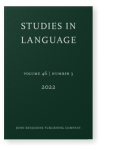Vol. 46:3 (2022) ► pp.559–593
Through space, relations, and thoughts
The system of postpositions in Karijona (Cariban, Amazonia)
This paper aims to describe the morphosyntax and semantics of postpositions in Karijona, a Cariban language from Northwest Amazonia. The data, collected in the Karijona settlement of Puerto Nare (Colombia), were analyzed according to Basic Linguistic Theory and Cognitive Semantics. Like other Cariban languages, Karijona has a typologically unusual system of postpositions, which can cross-reference person and number, and form complex stems consisting of locative roots and locative suffixes. In terms of their semantics, the system distinguishes among spatial, relational, and ‘mental state’ postpositions. The first type encodes noun classification, orientation, and distance. While the second type has prototypical relational meanings, the third refers to cognitive and emotional states. This paper presents the first systematic description of the Karijona postpositions.
Article outline
- 1.Introduction
- 2.Typological profile of Karijona
- 3.Previous work on postpositional systems among Cariban languages
- 4.Karijona postpositions
- 4.1Morphology of postpositions in Karijona
- 4.1.1Segmentable postpositional stems
- 4.1.2Non-segmentable postpositional stems
- 4.1.3Status of monosyllabic postpositions in Karijona
- 4.2Syntax of postpositional phrases in Karijona
- 4.3Spatial postpositions
- 4.3.1Classificatory postpositions
- A-i. general place and the locative root ho
- A-ii. aquatic place and the locative root ka
- A-iii. elongated place and the locative root rana
- A-iv. bounded place and the locative root ta
- A-v. animate referents and the postposition ʤa
- 4.3.2Orientational postpositions
- B-i. behind and the locative root ga
- B-ii. under and the locative root da, including ehɨne
- B-iii. front and the non-segmentable waho
- B-iv. above and the non-segmentable həkə and reto
- 4.3.3Distantial postpositions
- C-i. deictic sides and the non-segmentable kɨnəkə and bəbəkə
- C-ii. the adverbial mɨha and mɨhake
- 4.3.1Classificatory postpositions
- 4.4Relational postpositions
- 4.5Mental state postpositions
- E-i. cognitive
- E-ii. emotional
- 4.1Morphology of postpositions in Karijona
- 5.Summary
- Notes
- Abbreviations
-
References
